heating GMC SAVANA 1997 Owners Manual
[x] Cancel search | Manufacturer: GMC, Model Year: 1997, Model line: SAVANA, Model: GMC SAVANA 1997Pages: 388, PDF Size: 20.17 MB
Page 76 of 388
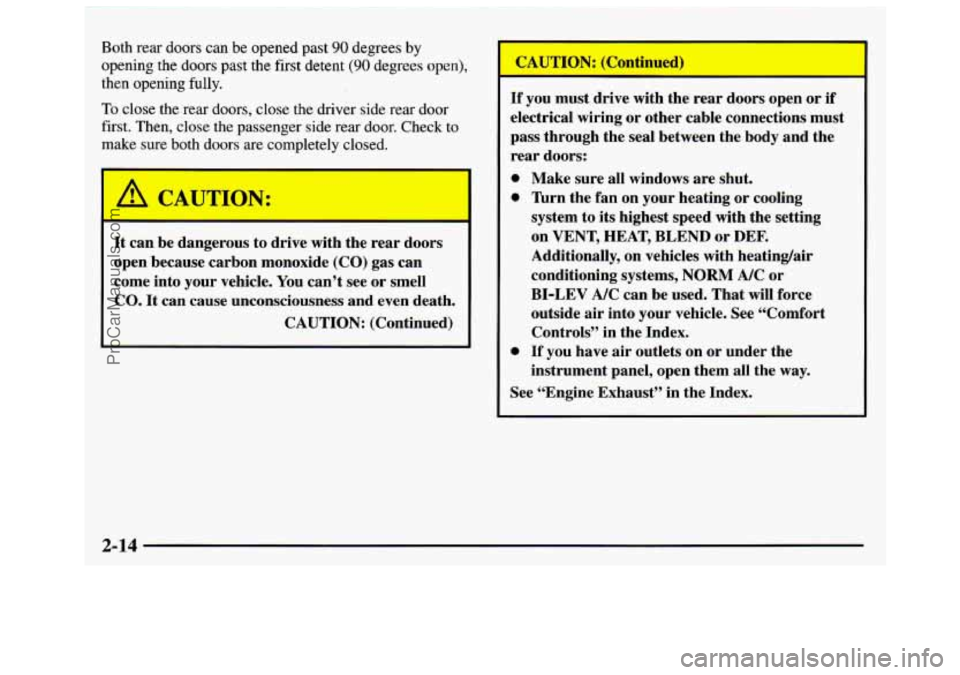
Both rear doors can be opened past 90 degrees by
opening the doors past the first detent
(90 degrees open),
then opening fully.
To close the rear doors, close the driver side rear door
first. Then, close the passenger side rear door. Check to
make sure both doors are completely closed.
It can be dangerous to drive with the rear doors
open because carbon monoxide
(CO) gas can
come into your vehicle. You can’t see or smell
CO. It can cause unconsciousness and even death.
CAUTION: (Continued)
If you must drive with the rear doors open or if
electrical wiring or other cable connections must
pass through the seal between the body and the
rear doors:
0
0
0
Make sure all windows are shut.
Turn the fan on your heating or cooling
system to its highest speed with the setting
on VENT, HEAT, BLEND or DEF.
Additionally, on vehicles with heatingair
conditioning systems,
NORM A/C or
BI-LEV
A/C can be used. That will force
outside
air into your vehicle. See “Comfort
Controls” in the Index.
If you have air outlets on or under the
instrument panel, open them all the way.
See “Engine Exhaust” in the Index.
2-14
ProCarManuals.com
Page 93 of 388
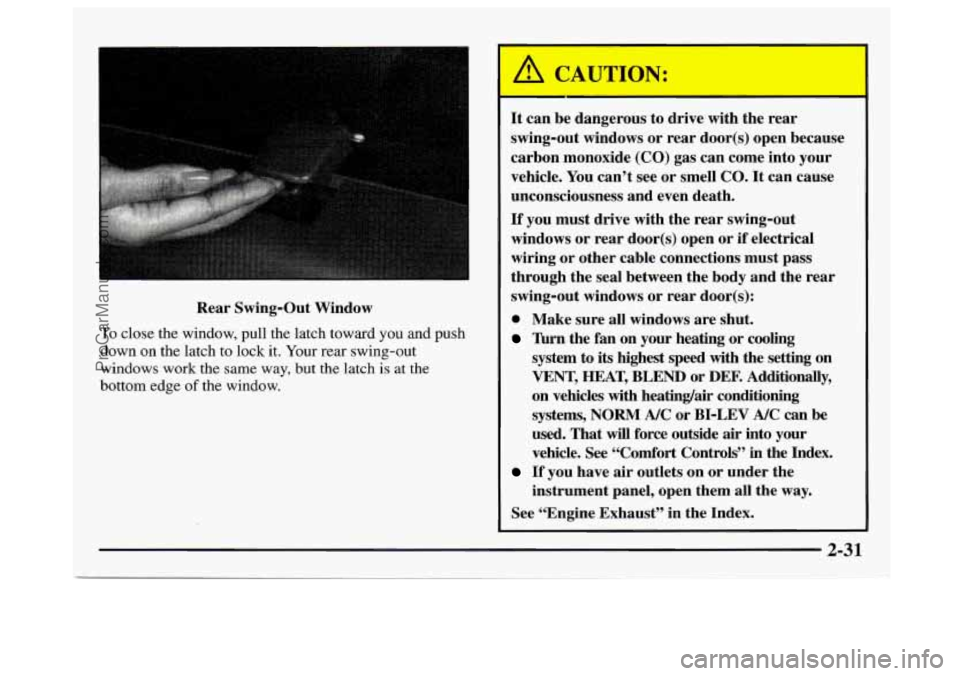
Rear Swing-Out Window
To close the window, pull the latch toward you and push
down
on the latch to lock it. Your rear swing-out
windows work the same way, but the latch is
at the
bottom edge
of the window.
It can be dangerous to drive with the rear
swing-out windows or rear door(s) open because
carbon monoxide
(CO) gas can come into your
vehicle. You can’t see or smell
CO. It can cause
unconsciousness and even death.
If you must drive with the rear swing-out
windows or rear door(s) open or
if electrical
wiring or other cable connections must pass
through the seal between the body and the rear
swing-out windows or rear door(s):
0 Make sure all windows are shut.
Turn the fan on your heating or cooling
system to its highest speed with the setting on
VENT, HEAT, BLEND or DEF. Additionally,
on vehicles with heatingair conditioning
systems,
NORM A/C or BI-LEV A/C can be
used. That will force outside air into your
vehicle. See
“Comfort Controls” in the Index.
instrument panel, open them
all the way.
If you have air outlets on or under the
See “Engine Exhaust” in the Index.
2-31
ProCarManuals.com
Page 108 of 388
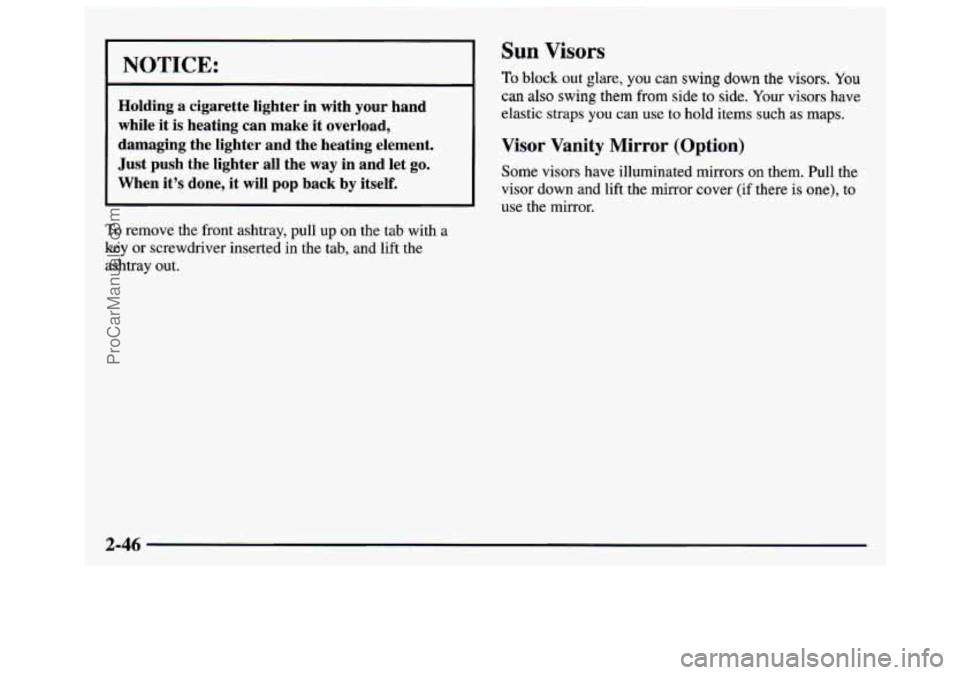
NOTICE:
Holding a cigarette lighter in with your hand
while it is heating can make it overload,
damaging the lighter and the heating element.
Just push the lighter all the way in and let
go.
When it’s done, it will pop back by itself.
To remove the front ashtray, pull up on the tab with a
key or screwdriver inserted in the tab, and lift the
ashtray out.
Sun Visors
To block out glare, you can swing down the visors. You
can also swing them from side to side. Your visors have
elastic straps
you can use to hold items such as maps.
Visor Vanity Mirror (Option)
Some visors have illuminated mirrors on them. Pull the
visor down and lift the mirror cover
(if there is one), to
use the mirror.
2-46
ProCarManuals.com
Page 121 of 388
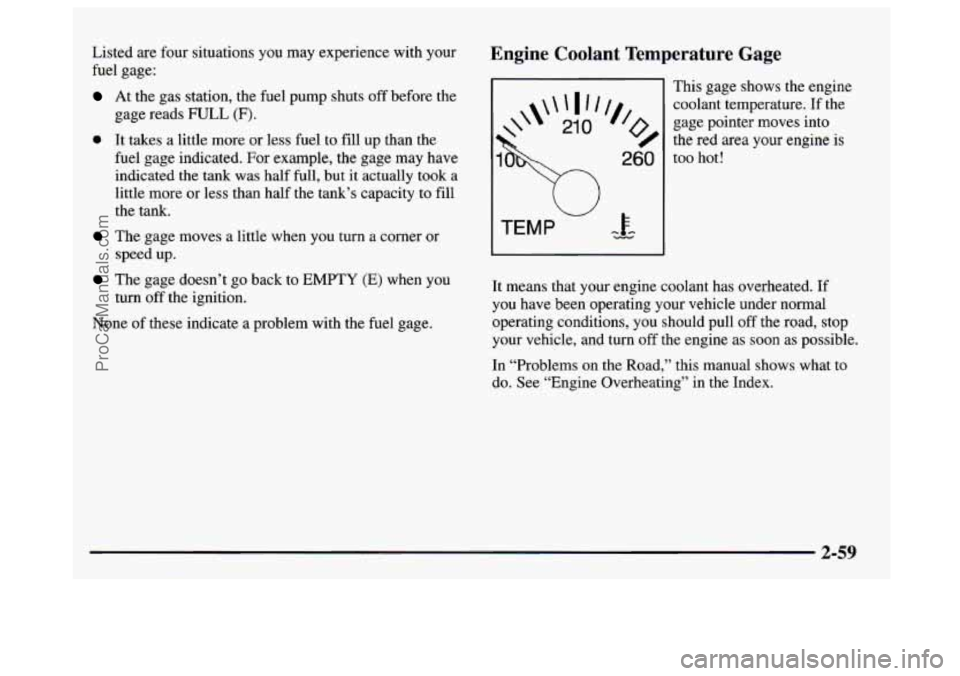
Listed are four situations you may experience with your
fuel gage:
At the gas station, the fuel pump shuts off before the
gage reads FULL (F).
0 It takes a little more or less fuel to fill up than the
fuel gage indicated. For example, the gage may have
indicated the tank was half full, but
it actually took a
little more or less than half the tank’s capacity to fill
the tank.
The gage moves a little when you turn a corner or
speed up.
The gage doesn’t go back to EMPTY (E) when you
None of these indicate a problem with the fuel gage.
turn off
the ignition.
Engine Coolant Temperature Gage
W
TEMP
This gage shows the engine
coolant temperature. If the
gage pointer moves into
the red area your engine is
too
hot!
It means that your engine coolant has overheated. If
you have been operating your vehicle under normal
operating conditions, you should pull off the road, stop
your vehicle, and turn off the engine as
soon as possible.
In “Problems on the Road,” this manual shows what to
do. See “Engine Overheating” in the Index.
2-59
ProCarManuals.com
Page 127 of 388
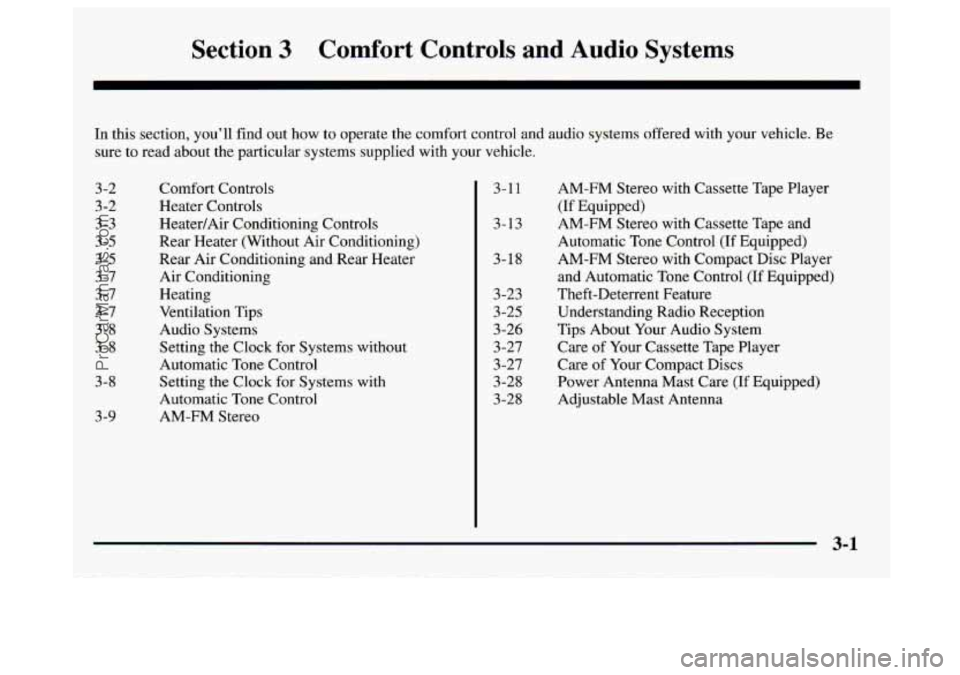
Section 3 Comfort Controls and Audio Systems
In this section, you’ll find out how to operate the comfort control and audio systems offered with your vehicle. Be
sure to read about the particular systems supplied with your vehicle.
3-2
3-2
3-3
3-5
3-5
3 -7
3
-7
3 -7
3-8
3-8
3-8
3-9 Comfort Controls
Heater Controls
Heater/Air Conditioning Controls
Rear
Heater (Without Air Conditioning)
Rear Air Conditioning and Rear Heater
Air Conditioning
Heating
Ventilation Tips
Audio Systems
Setting the Clock for Systems without
Automatic Tone Control
Setting the Clock for Systems with
Automatic Tone Control
AM-FM Stereo
3-1 1
3-13
3-18
3-23
3-25 3-26
3-27
3-27
3-28
3-28 AM-FM
Stereo with Cassette Tape Player
(If Equipped)
AM-FM Stereo with Cassette Tape and
Automatic Tone Control (If Equipped)
AM-FM Stereo with Compact Disc Player
and Automatic Tone Control (If Equipped)
Theft-Deterrent Feature
Understanding Radio Reception
Tips About Your Audio System
Care of Your Cassette Tape Player
Care of Your Compact Discs
Power Antenna Mast Care
(If Equipped)
Adjustable Mast Antenna
3-1
ProCarManuals.com
Page 128 of 388
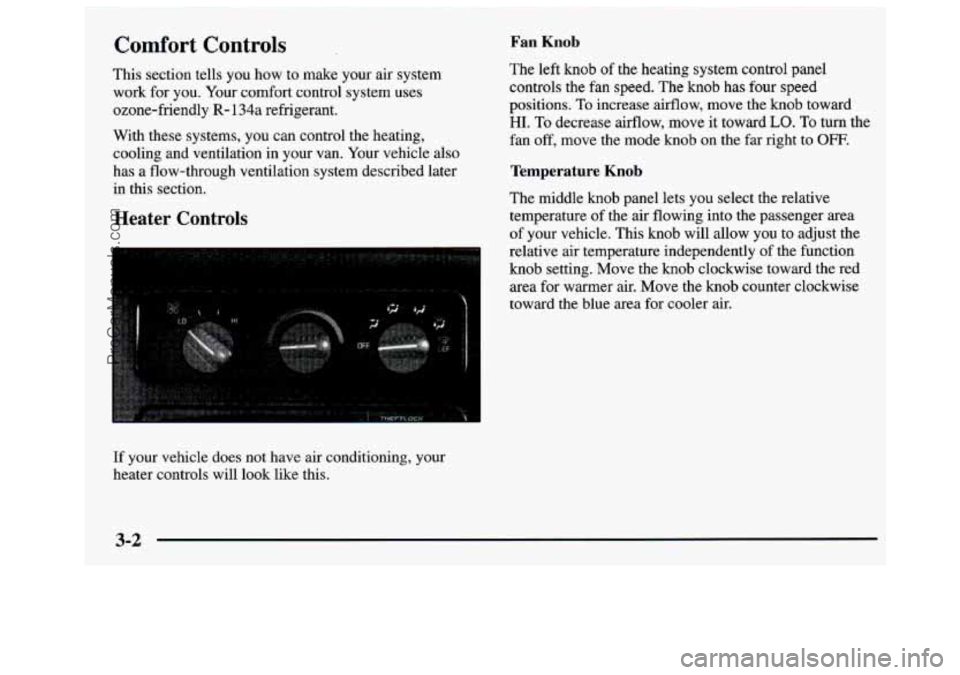
Comfort Controls Fan Knob
This section tells you how to make your air system The left knob of
the heating system control panel
work for
you. Your comfort control system uses controls the fan speed.
The knob has four speed
ozone-friendly
R- 134a refrigerant. positions. To increase
airflow, move the knob toward
With these systems, you can control the heating, fan off, move the mode knob on the far right to
OFF.
cooling and ventilation in your van. Your vehicle also
has a flow-through ventilation system described later
Temperature Knob
in this section.
The middle knob panel lets you select the relative
Heater Controls temperature of the air flowing into the passenger area
of your vehicle. This
knob will allow you to adjust the
relative air temperature independently of the function
knob setting. Move the knob clockwise toward the red
area for warmer air. Move the knob counter clockwise
toward the blue area for cooler air.
HI. To decrease airflow, move it toward LO. To turn the
If your vehicle does not have air conditioning, your
heater controls will look like this.
3-2
ProCarManuals.com
Page 130 of 388
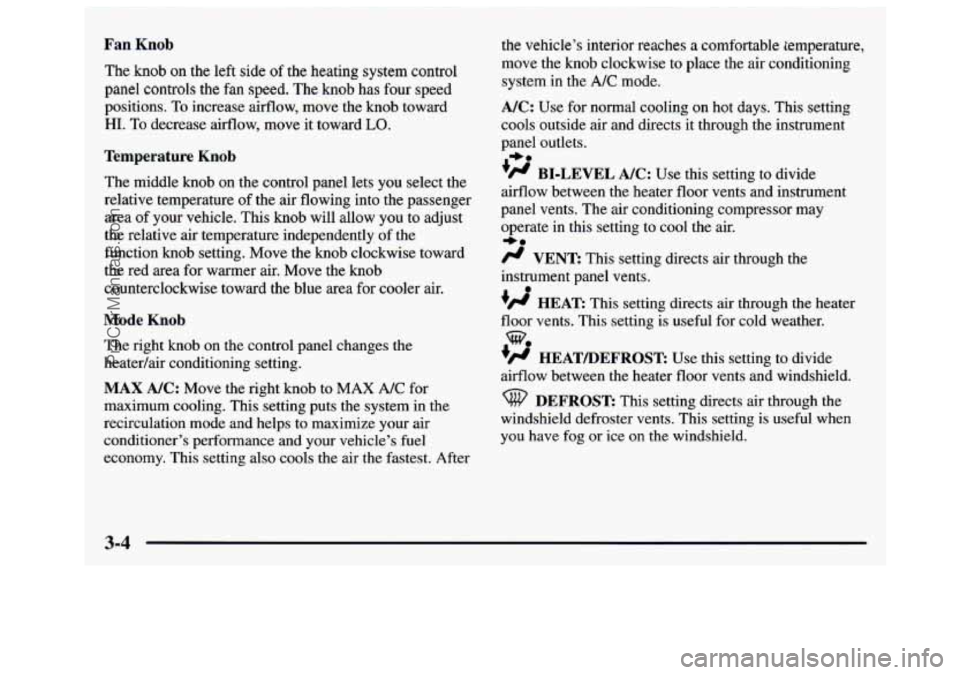
Fan Knob
The knob on the left side of the heating system control
panel controls the
€an speed. The knob has four speed
positions.
To increase airflow, move the knob toward
HI. To decrease airflow, move it toward LO.
Temperature Knob
The middle knob on the control panel lets you select the
relative temperature of the air flowing into the passenger
area of your vehicle. This knob will allow you to adjust
the relative air temperature independently of the
function knob setting. Move the knob clockwise toward
the red area for warmer air. Move the knob
counterclockwise toward the blue area for cooler air.
Mode Knob
The right knob on the control panel changes the
heatedair conditioning setting.
MAX A/C: Move the right knob to MAX A/C for
maximum cooling. This setting puts the system in the
recirculation mode and helps to maximize your air
conditioner’s performance and your vehicle’s fuel
economy. This setting also cools the air the fastest. After
the vehicle’s interior reaches a comfortable temperature,
move the knob clockwise to place
the air conditioning
system in the
A/C mode.
A/C: Use for normal cooling on hot days. This setting
cools outside air and directs it through the instrument
panel outlets.
’# BI-LEVEL A/C: Use this setting to divide
airflow between the heater floor vents and instrument
panel vents. The air conditioning compressor
may
operate in this setting to cool the air.
/J VENT: This setting directs air through the
instrument panel vents.
+H HEAR This setting directs air through the heater
floor vents. This setting is useful for cold weather.
+H HEATLIEFROST: Use this setting to divide
airflow between the heater floor vents and windshield.
I,.
*e
0
DEFROST This setting directs air through the
windshield defroster vents. This setting is useful when
you have fog
or ice on the windshield.
3-4
ProCarManuals.com
Page 132 of 388
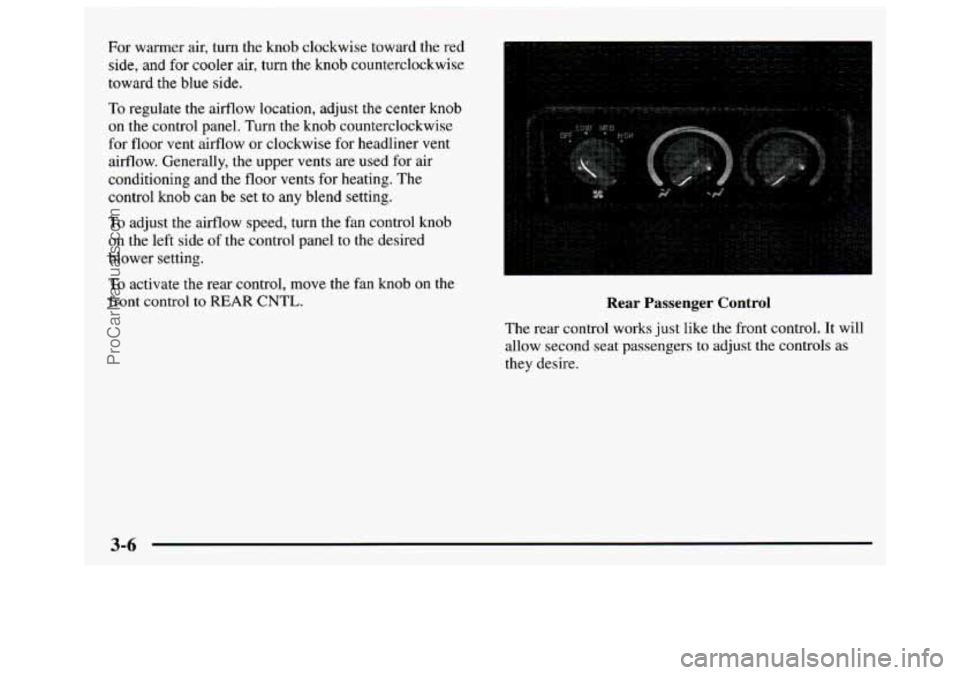
For warmer air, turn the knob clockwise toward the red
side,
and for cooler air, turn the knob counterclockwise
toward the blue
side.
10 regulate the airflow location, adjust the center knob
on the control panel. Turn the knob counterclockwise
for floor vent airflow or clockwise for headliner
vent
airflow. Generally, the upper vents are used for air
conditioning and
the floor vents for heating. The
control knob can be set
to any blend setting.
To adjust the airflow speed, turn the fan control knob
on the left side of the control panel to the desired
blower setting.
To activate the rear control, move the fan knob on the
front control to REAR CNTL. Kear rassenger Control
The rear control works just like the front control. It will
allow second seat passengers to adjust the controls as
they desire.
3-6
ProCarManuals.com
Page 133 of 388
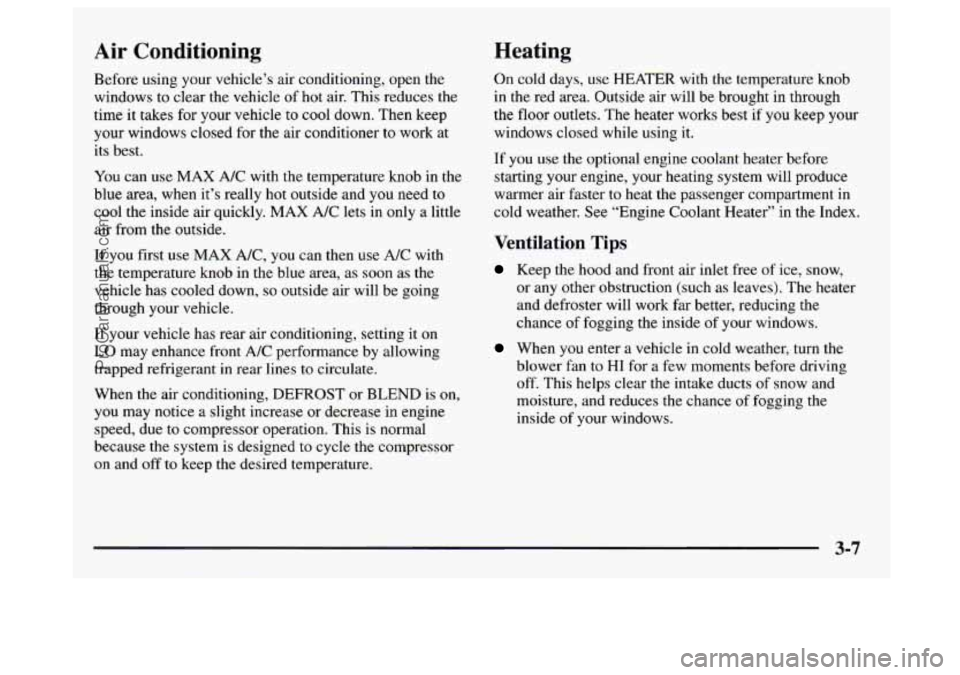
Air Conditioning Heating
Before using your vehicle’s air conditioning, open the
windows to clear the vehicle of hot air. This reduces the
time it takes for your vehicle to cool down. Then keep
your windows closed for the air conditioner to work at
its best.
You can use
MAX A/C with the temperature knob in the
blue area, when it’s really hot outside and you need to
cool the inside air quickly.
MAX A/C lets in only a little
air from
the outside.
If you first use
MAX A/C, you can then use A/C with
the temperature knob in the blue area, as soon as the
vehicle has cooled down,
so outside air will be going
through your vehicle.
If your vehicle has rear air conditioning, setting it on
LO may enhance front A/C performance by allowing
trapped refrigerant in rear lines
to circulate.
When the air conditioning, DEFROST
or BLEND is on,
you may notice
a slight increase or decrease in engine
speed, due to compressor operation. This
is normal
because the system is designed
to cycle the compressor
on and off to keep the desired temperature. On cold
days, use
HEATER with the temperature knob
in the red area. Outside air will be brought in through
the
floor outlets. The heater works best if you keep your
windows closed while using it.
If you use the optional engine coolant heater before
starting your engine, your heating system will produce
warmer air faster to heat the passenger compartment in
cold weather. See “Engine Coolant Heater” in the Index.
Ventilation Tips
Keep the hood and front air inlet free of ice, snow,
or any other obstruction (such as leaves). The heater
and defroster will work far better, reducing the
chance of fogging the inside of your windows.
When you enter a vehicle in cold weather, turn the
blower fan to
HI for a few moments before driving
off. This helps clear the intake ducts of snow and
moisture, and reduces the chance of fogging the
inside of your windows.
3-7
ProCarManuals.com
Page 188 of 388

Safety Chains
You should always attach chains between your vehicle
and your trailer.
Cross the safety chains under the tongue
of the trailer
so that the tongue will not drop to the road
if it becomes separated from the hitch. Instructions
about safety chains may be provided by the hitch
manufacturer or by the trailer manufacturer. Follow the
manufacturer’s recommendation for attaching safety
chains and do not attach them to the bumper. Always
leave just enough slack
so you can turn with your rig.
And, never allow safety chains to drag on the ground.
Driving with a Trailer
Trailer Brakes
If your trailer weighs more than 1,000 lbs. (450 kg)
loaded, then
it needs its own brakes -- and they must be
adequate. Be sure to read and follow the instructions for
the trailer brakes so you’ll be able to install, adjust and
maintain them properly.
If you have a rear-most window open and you
pull a trailer with your vehicle, carbon monoxide
(CO) could come into your vehicle.
You can’t see
or smell CO. It can cause unconsciousness or
death. (See “Engine Exhaust” in the Index.)
To
maximize your safety when towing a trailer:
Have your exhaust system inspected for
leaks, and make necessary repairs before
starting on your trip.
Keep the rear-most windows closed.
If exhaust does come into your vehicle
through a window in the rear or another
opening, drive with your front, main
heating or cooling system on and with the
fan on any speed. This will bring fresh,
outside air into your vehicle.
Do not use
MAX A/C because it only recirculates the
air inside your vehicle. (See
“ Comfort
Controls’’ in the Index.)
4-34
ProCarManuals.com